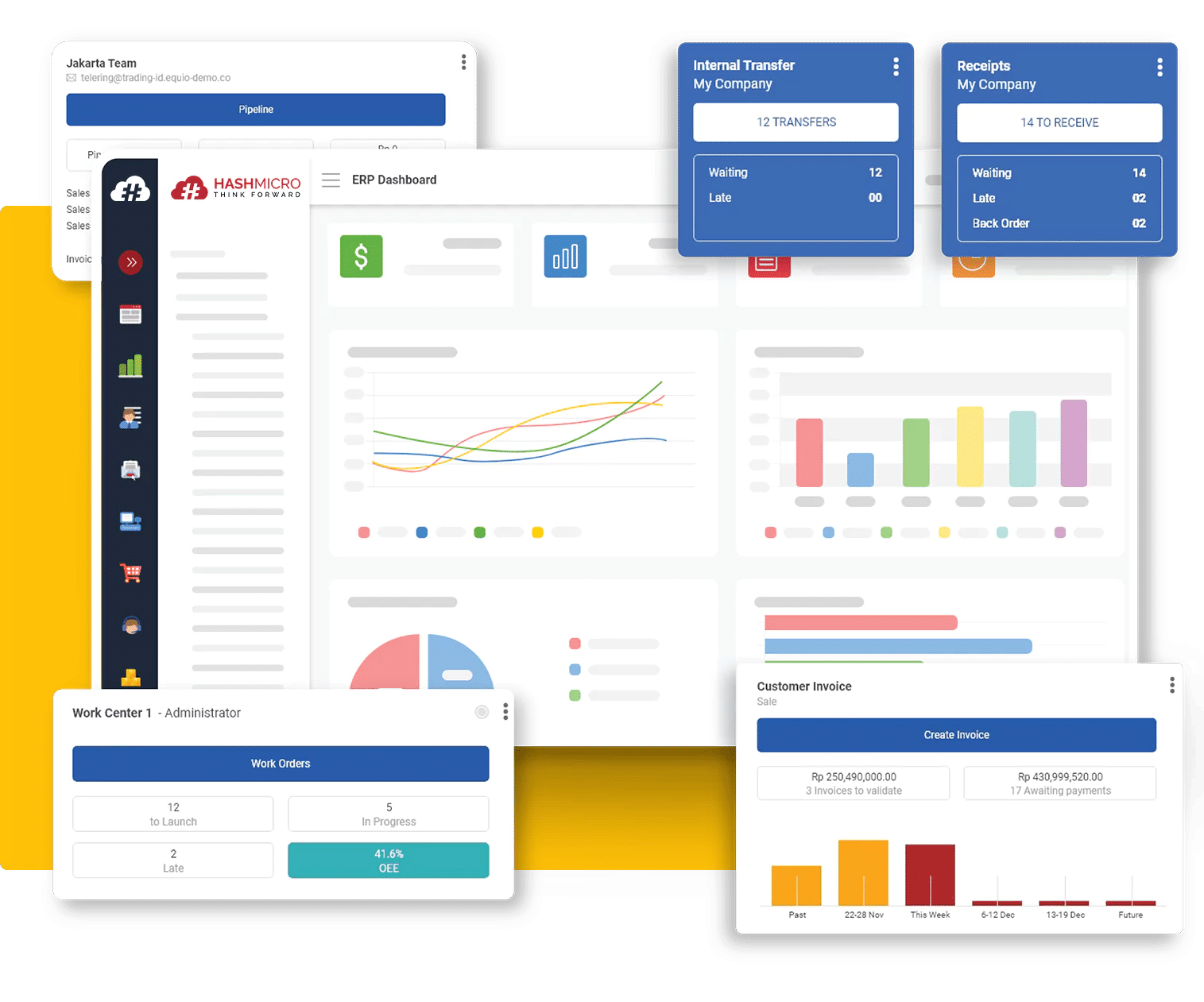The previous article discussed the importance of digital transformation in business. Next, we will explore why the supply chain, one of the most crucial aspects of business, also needs digital transformation.
The supply chain is a complex system encompassing various aspects and processes including procurement, inventory, warehousing, sales, and distribution. All these aspects are vital for business continuity.
Therefore, the role of digitalization in supply chain management is highly significant. According to a survey by Gartner, digital transformation of the supply chain can increase company revenue by up to 10%. However, ironically, only 15% of the companies researched are preparing themselves for digitalization.
Moreover, the complexity of the supply chain process makes it vulnerable to disruptions. Disruptions in the supply chain can lead to various problems, including increased operational costs, delays in product delivery, reputation damage, and decreased customer satisfaction.
Supply chain disruptions can hinder company performance, thus threatening business continuity in a competitive environment. Therefore, digital transformation in supply chain management is a necessity, not just an option.
Key Takeaways
|
Table of Contents
Benefits of Digital Transformation in Supply Chain Management
Implementing digital transformation in supply chain management offers numerous benefits. In addition to keeping businesses competitive, it also allows for the optimization of the entire supply chain process from start to finish.
Here are some of the main benefits of supply chain digitalization:
- Increased profits: Companies that digitize their supply chain processes see an annual revenue increase of 3.2%.
- Cost savings: Businesses that optimize their supply chains achieve cost reductions of up to 15%.
- Faster supply chain cycle: Digitized supply chain processes are proven to be three times faster in the cash-to-cash cycle.
- Improved operational efficiency: Supply chain management with AI assistance is 67% more effective than conventional supply chains.
- Better business decisions: With accurate data contributions from the system, and supply chain knowledge from professionals, companies can make higher-quality decision using AI supply chain AI supply chain technology to optimize processes and enhance decision-making.
Differences Between Conventional and Digital Supply Chain
| Aspect | Conventional SCM | Digital SCM |
| Procurement | 55% of companies fail to make good decisions due to a lack of understanding of procurement data processing. | 82% of companies find procurement processes easier with digitalization. |
| Inventory | Over 30% of businesses are impacted by inaccurate inventory information. | Companies implementing digital transformation experience 2.5 times faster profit gains. |
| Warehouse | 55% of distributors frequently face payment delays due to messy transaction records. | 26% of warehouse management system users report significant time savings. |
| Sales | Conventional sales see a 1.7% increase in prospect-to-customer conversion rates. | Digital sales see a 9.9% increase in prospect-to-customer conversion rates. |

The table above summarizes the significant differences in approach and implementation between conventional/manual supply chain management (SCM) and digital SCM, showcasing the transformative impact of digitalization on procurement, inventory, warehouse, and sales aspects.
Signs Your Current System Is No Longer Relevant
The signs that a manual or simplistic system in a company is no longer sufficient for supply chain management are often visible from a number of negative effects that can impact company performance. One of the most striking negative effects is the limitation in integration between various key functions, such as procurement, inventory, warehouse, and sales.
When systems are not well integrated, companies may struggle to manage supply chain processes holistically. Manual systems in inventory, warehouse, procurement, and sales management often fail to provide accurate visibility of stock and sales data.
Without effective integration, companies struggle to monitor stock in real-time, which can lead to inefficient overstocking or stock shortages. Manual processes are prone to errors and delays in warehouse management, and they hinder the company’s ability to make timely business decisions.
Consequences of Rejecting Technology in Your Business Processes
According to Onlinedegrees study As many as 63% of companies have not yet implemented digital software to manage their supply chains. Apart from being unaware of digital systems, many companies choose to remain manual because they feel they do not need it. However, is this the best step for the company?
In this modern era, speed and accuracy are the key drivers of success. Companies that cannot adapt quickly risk falling behind and being marginalized in market competition. Moreover, with the increasing complexity of supply chain processes, the use of technology is a necessity.
High expenses, low profits
Companies tend to face higher operational costs due to inefficient management. Additionally, disruptions in the supply chain can result in losses up to $228 million.
As a result, even though companies may be able to sell their products, the profits generated tend to be lower due to high operational costs and low efficiency.
Delivery delays and reporting
If companies do not have an effective planning system, they may struggle to forecast demand, manage inventory, or set accurate production schedules. This can result in delays in fulfilling customer orders.
Poor quality data
Poor quality data is caused by two main things: human error and separate, unstructured data management. Consequently, there will be a lot of bad, inaccurate, or even missing data from the database. In the realm of the supply chain, bad data causes losses up to $600 billion per year based on journal industrial engineering and management.
Lack of supply chain visibility
Surveys state that 57% of businesses have poor visibility over their supply chain management. Why is this?
Because businesses cannot track and monitor the flow of goods in a timely manner throughout the supply chain. Fragmented manual processes and unintegrated systems further exacerbate this lack of visibility.
Inability to respond to market changes
Conventional supply chains lack the flexibility to respond to rapid market changes. Manual processes make it difficult for companies to quickly adjust production, distribution, or stock strategies in response to changes in demand or market competition.
A real example is during the COVID-19 pandemic. Extreme and rapid market changes caused 57% of companies to experience significant profit declines. Naturally, their supply chains also faced disruptions.
In this case, you can make your company avoid these consequences by using supply chain management software. Get the price scheme immediately by clicking the banner below.

Overcoming Supply Chain Challenges with a Digital System

Managing a supply chain is a complex task. Many companies struggle to handle the entire process without effective supply chain management. Therefore, using supply chain management software can greatly assist companies in managing each aspect well.
One of the best supply chain management systems in Philippines is HashMicro. HashMicro’s technology is designed to simplify and optimize processes from start to finish. From raw material procurement, inventory storage, warehouse management, to sales management, HashMicro software can facilitate each stage.
HashMicro’s supply chain management system is equipped with comprehensive features aimed at optimizing company operational activities. Here are some of HashMicro’s standout features for effective supply chain management:
Supply chain process automation
With integrated automation technology, this software helps companies automate routine tasks such as inventory management, order processing, shipment monitoring, and demand forecasting.
Seamless data integration
The digital system can combine data from various sources, including suppliers, manufacturers, distributors, and customers, into a single integrated platform. Thus, companies can access comprehensive and real-time information about stock, demand, and delivery status.
End-to-end supply chain process management
The digital system ensures that the entire supply chain process runs smoothly, from procurement, stock storage in warehouses, to delivery of goods to customers. Therefore, companies can update the supply chain cycle more quickly while addressing potential risks.
Advanced data analysis
This software utilizes advanced data analysis techniques such as machine learning and big data analytics to identify complex patterns in supply chain data. As a result, companies can be more responsive to sudden market changes.
Planning and forecasting management
This software provides tools necessary for making accurate demand forecasts based on historical data, market trends, and other factors. Additionally, this feature is useful for planning inventory, production, and distribution needs more timely and efficiently.
Now you know the benefits of digital transformation in supply chain management. However, if you would like to learn more about what a supply chain is, you can read our article. You can also read about supply chain management recommendations for your company.
Case Study: The Impact of Digital Transformation on Business Processes
Research from McKinsey states that companies digitizing their supply chains can experience an increase in annual profit of 3.2% (before interest and taxes).
Additionally, research from the Logistics Bureau indicates that reducing supply chain costs by 5% can double the net profit. One way to reduce operational costs is by implementing a competent and scalable supply chain management system.
Here is an example of a company that achieved success by implementing digital transformation, particularly in the area of supply chain management:
Pfizer: Mass Vaccine Production with Competent Management

Pfizer, one of the largest pharmaceutical companies in the world, faced significant logistical challenges in adapting its supply chain to produce and distribute the COVID-19 vaccine in a short time.
They recognized the urgency of the situation, understanding that any delay could have fatal consequences for patients. To save millions of lives, Pfizer rapidly transformed its supply chain and improved production efficiency. It is important to note that Pfizer produced 200 million doses of vaccine in a year.
This transformation was not easy. Pfizer had to adapt to changes in the global landscape and enhance visibility and accountability in their supply chain. To meet these challenges, Pfizer was well-prepared in advance. They moved their supply chain to the cloud in 2012 and introduced a highly organized supply network in 2015.
These steps provided better visibility into product status and enabled faster responses to demand.
Furthermore, Pfizer strengthened its presence in the e-commerce space, providing online access to their prescription drugs. This not only increased the accessibility of medications but also provided more detailed data to manage demand and better analyze market needs.
With over 24,000 SKUs and 200 contract manufacturers in 175 countries, Pfizer understands the importance of tracking products throughout their supply chain. Through the Highly Orchestrated Supply Network (HOSuN) initiative, Pfizer aims to strengthen their supply chain at every stage by using available digital solutions to support this transformation.
Conclusion
Digital transformation in supply chain management plays a crucial role in achieving more efficient, cost-effective, and responsive operations. With the adoption of the right technology, companies can optimize each stage of their supply chain by enhancing visibility, minimizing risks, and improving responsiveness to market changes.
One of the best supply chain management systems for your company is HashMicro. With its comprehensive features tailored to your company’s needs, you no longer need to worry about time-consuming and costly supply chain management. If you are interested in seeing how our system works, you can register for a free demo.

This article is the second edition in the series on the Importance of Digital Transformation for Business. In the next article, you can learn more about manufacturing, financial management, and asset maintenance.




































